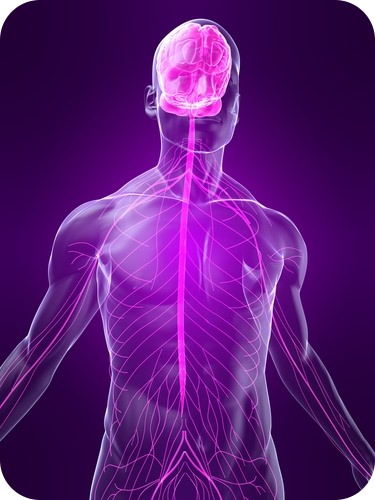13.7: Peripheral Nervous System
- Page ID
- 13281
\( \newcommand{\vecs}[1]{\overset { \scriptstyle \rightharpoonup} {\mathbf{#1}} } \)
\( \newcommand{\vecd}[1]{\overset{-\!-\!\rightharpoonup}{\vphantom{a}\smash {#1}}} \)
\( \newcommand{\dsum}{\displaystyle\sum\limits} \)
\( \newcommand{\dint}{\displaystyle\int\limits} \)
\( \newcommand{\dlim}{\displaystyle\lim\limits} \)
\( \newcommand{\id}{\mathrm{id}}\) \( \newcommand{\Span}{\mathrm{span}}\)
( \newcommand{\kernel}{\mathrm{null}\,}\) \( \newcommand{\range}{\mathrm{range}\,}\)
\( \newcommand{\RealPart}{\mathrm{Re}}\) \( \newcommand{\ImaginaryPart}{\mathrm{Im}}\)
\( \newcommand{\Argument}{\mathrm{Arg}}\) \( \newcommand{\norm}[1]{\| #1 \|}\)
\( \newcommand{\inner}[2]{\langle #1, #2 \rangle}\)
\( \newcommand{\Span}{\mathrm{span}}\)
\( \newcommand{\id}{\mathrm{id}}\)
\( \newcommand{\Span}{\mathrm{span}}\)
\( \newcommand{\kernel}{\mathrm{null}\,}\)
\( \newcommand{\range}{\mathrm{range}\,}\)
\( \newcommand{\RealPart}{\mathrm{Re}}\)
\( \newcommand{\ImaginaryPart}{\mathrm{Im}}\)
\( \newcommand{\Argument}{\mathrm{Arg}}\)
\( \newcommand{\norm}[1]{\| #1 \|}\)
\( \newcommand{\inner}[2]{\langle #1, #2 \rangle}\)
\( \newcommand{\Span}{\mathrm{span}}\) \( \newcommand{\AA}{\unicode[.8,0]{x212B}}\)
\( \newcommand{\vectorA}[1]{\vec{#1}} % arrow\)
\( \newcommand{\vectorAt}[1]{\vec{\text{#1}}} % arrow\)
\( \newcommand{\vectorB}[1]{\overset { \scriptstyle \rightharpoonup} {\mathbf{#1}} } \)
\( \newcommand{\vectorC}[1]{\textbf{#1}} \)
\( \newcommand{\vectorD}[1]{\overrightarrow{#1}} \)
\( \newcommand{\vectorDt}[1]{\overrightarrow{\text{#1}}} \)
\( \newcommand{\vectE}[1]{\overset{-\!-\!\rightharpoonup}{\vphantom{a}\smash{\mathbf {#1}}}} \)
\( \newcommand{\vecs}[1]{\overset { \scriptstyle \rightharpoonup} {\mathbf{#1}} } \)
\( \newcommand{\vecd}[1]{\overset{-\!-\!\rightharpoonup}{\vphantom{a}\smash {#1}}} \)
\(\newcommand{\avec}{\mathbf a}\) \(\newcommand{\bvec}{\mathbf b}\) \(\newcommand{\cvec}{\mathbf c}\) \(\newcommand{\dvec}{\mathbf d}\) \(\newcommand{\dtil}{\widetilde{\mathbf d}}\) \(\newcommand{\evec}{\mathbf e}\) \(\newcommand{\fvec}{\mathbf f}\) \(\newcommand{\nvec}{\mathbf n}\) \(\newcommand{\pvec}{\mathbf p}\) \(\newcommand{\qvec}{\mathbf q}\) \(\newcommand{\svec}{\mathbf s}\) \(\newcommand{\tvec}{\mathbf t}\) \(\newcommand{\uvec}{\mathbf u}\) \(\newcommand{\vvec}{\mathbf v}\) \(\newcommand{\wvec}{\mathbf w}\) \(\newcommand{\xvec}{\mathbf x}\) \(\newcommand{\yvec}{\mathbf y}\) \(\newcommand{\zvec}{\mathbf z}\) \(\newcommand{\rvec}{\mathbf r}\) \(\newcommand{\mvec}{\mathbf m}\) \(\newcommand{\zerovec}{\mathbf 0}\) \(\newcommand{\onevec}{\mathbf 1}\) \(\newcommand{\real}{\mathbb R}\) \(\newcommand{\twovec}[2]{\left[\begin{array}{r}#1 \\ #2 \end{array}\right]}\) \(\newcommand{\ctwovec}[2]{\left[\begin{array}{c}#1 \\ #2 \end{array}\right]}\) \(\newcommand{\threevec}[3]{\left[\begin{array}{r}#1 \\ #2 \\ #3 \end{array}\right]}\) \(\newcommand{\cthreevec}[3]{\left[\begin{array}{c}#1 \\ #2 \\ #3 \end{array}\right]}\) \(\newcommand{\fourvec}[4]{\left[\begin{array}{r}#1 \\ #2 \\ #3 \\ #4 \end{array}\right]}\) \(\newcommand{\cfourvec}[4]{\left[\begin{array}{c}#1 \\ #2 \\ #3 \\ #4 \end{array}\right]}\) \(\newcommand{\fivevec}[5]{\left[\begin{array}{r}#1 \\ #2 \\ #3 \\ #4 \\ #5 \\ \end{array}\right]}\) \(\newcommand{\cfivevec}[5]{\left[\begin{array}{c}#1 \\ #2 \\ #3 \\ #4 \\ #5 \\ \end{array}\right]}\) \(\newcommand{\mattwo}[4]{\left[\begin{array}{rr}#1 \amp #2 \\ #3 \amp #4 \\ \end{array}\right]}\) \(\newcommand{\laspan}[1]{\text{Span}\{#1\}}\) \(\newcommand{\bcal}{\cal B}\) \(\newcommand{\ccal}{\cal C}\) \(\newcommand{\scal}{\cal S}\) \(\newcommand{\wcal}{\cal W}\) \(\newcommand{\ecal}{\cal E}\) \(\newcommand{\coords}[2]{\left\{#1\right\}_{#2}}\) \(\newcommand{\gray}[1]{\color{gray}{#1}}\) \(\newcommand{\lgray}[1]{\color{lightgray}{#1}}\) \(\newcommand{\rank}{\operatorname{rank}}\) \(\newcommand{\row}{\text{Row}}\) \(\newcommand{\col}{\text{Col}}\) \(\renewcommand{\row}{\text{Row}}\) \(\newcommand{\nul}{\text{Nul}}\) \(\newcommand{\var}{\text{Var}}\) \(\newcommand{\corr}{\text{corr}}\) \(\newcommand{\len}[1]{\left|#1\right|}\) \(\newcommand{\bbar}{\overline{\bvec}}\) \(\newcommand{\bhat}{\widehat{\bvec}}\) \(\newcommand{\bperp}{\bvec^\perp}\) \(\newcommand{\xhat}{\widehat{\xvec}}\) \(\newcommand{\vhat}{\widehat{\vvec}}\) \(\newcommand{\uhat}{\widehat{\uvec}}\) \(\newcommand{\what}{\widehat{\wvec}}\) \(\newcommand{\Sighat}{\widehat{\Sigma}}\) \(\newcommand{\lt}{<}\) \(\newcommand{\gt}{>}\) \(\newcommand{\amp}{&}\) \(\definecolor{fillinmathshade}{gray}{0.9}\)
How does the signal get to your toes?
If the brain controls practically everything, how does the signal get to your toes? Or your legs? Or arms? By way of the peripheral nervous system, or all the nerves shown here other than the brain and spinal cord. Notice how they go everywhere.
Peripheral Nervous System
The peripheral nervous system (PNS) consists of all the nervous tissue that lies outside the central nervous system. It is shown in yellow in Figure below. It is connected to the central nervous system by nerves. A nerve is a cable-like bundle of axons. Some nerves are very long. The longest human nerve is the sciatic nerve. It runs from the spinal cord in the lower back down the left leg all the way to the toes of the left foot. Like the nervous system as a whole, the peripheral nervous system also has two divisions: the sensory division and the motor division.
- The sensory division of the PNS carries sensory information from the body to the central nervous system.
- The motor division of the PNS carries nerve impulses from the central nervous system to muscles and glands throughout the body. The nerve impulses stimulate muscles to contract and glands to secrete hormones. The motor division of the peripheral nervous system is further divided into the somatic and autonomic nervous systems.
 The nerves of the peripheral nervous system are shown in blue in this image. Can you identify the sciatic nerve?
The nerves of the peripheral nervous system are shown in blue in this image. Can you identify the sciatic nerve?Somatic Nervous System
The somatic nervous system (SNS) controls mainly voluntary activities that are under conscious control. It is made up of nerves that are connected to skeletal muscles. Whenever you perform a conscious movement, from signing your name to riding your bike, your somatic nervous system is responsible.
The somatic nervous system also controls some unconscious movements, called reflexes. A reflex is a very rapid motor response that is not directed by the brain. In a reflex, nerve impulses travel to and from the spinal cord in a reflex arc, like the one in Figure below. In this example, the person jerks his hand away from the flame without any conscious thought. It happens unconsciously because the nerve impulses bypass the brain.

A reflex arc like this one enables involuntary actions. How might reflex responses be beneficial to the organism
Autonomic Nervous System
All other involuntary activities not under conscious control are the responsibility of the autonomic nervous system (ANS). Nerves of the ANS are connected to glands and internal organs. They control basic physical functions such as heart rate, breathing, digestion, and sweat production. The autonomic nervous system also has two subdivisions: the sympathetic division and the parasympathetic division.
- The sympathetic division deals with emergency situations. It prepares the body for “fight or flight.” Do you get clammy palms or a racing heart when you have to play a solo or give a speech? Nerves of the sympathetic division control these responses.
- The parasympathetic division controls involuntary activities that are not emergencies. For example, it controls the organs of your digestive system so they can break down the food you eat.
Science Friday: The Agony and Ecstasy of Capsaicin
Have you ever tasted something spicy? In this video by Science Friday, Dr. Marco Tizzano discusses how capsaicin creates the burning sensation that some people enjoy.
Summary
- The peripheral nervous system consists of all the nervous tissue that lies outside the central nervous system. It is connected to the central nervous system by nerves.
- The peripheral nervous system has several divisions and subdivisions that transmit nerve impulses between the central nervous system and the rest of the body.
Review
- Identify the two major divisions of the peripheral nervous system.
- What is the role of the sensory division?
- Compare and contrast the somatic and autonomic nervous systems.
- What are the two divisions of the autonomic nervous system?
- What is the role of the sympathetic division?
| Image | Reference | Attributions |
 |
[Figure 1] | License: CC BY-NC |
 |
[Figure 2] | Credit: User:Persian Poet Gal/Wikipedia Source: commons.wikimedia.org/wiki/File:Nervous_system_diagram_%28dumb%29.png License: Public Domain |
 |
[Figure 3] | Credit: Rupali Raju Source: CK-12 Foundation License: CC BY-NC 3.0 |

